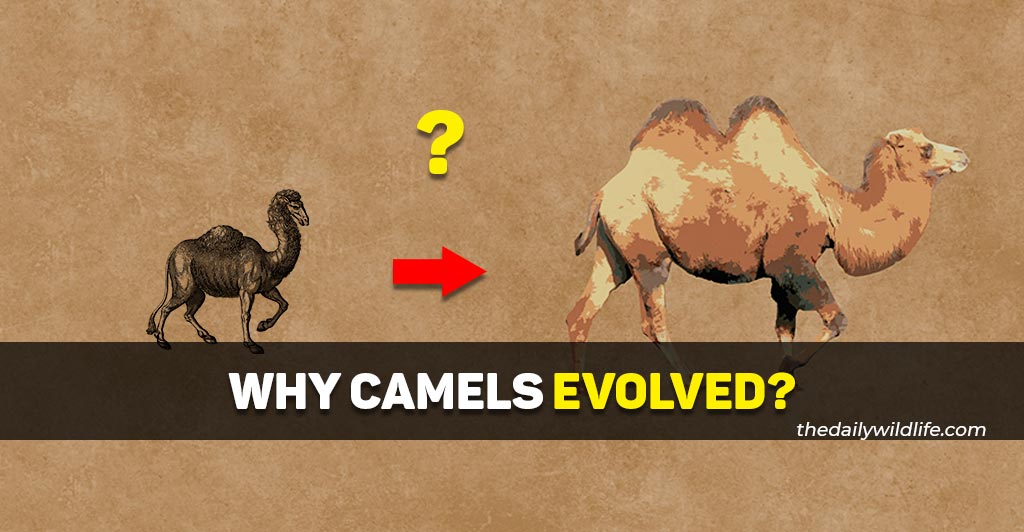During their evolutionary history, camels evolved because of natural selection and genetic stress, and to adapt to never-ending climate and environmental changes. Thick fur, pacing gait, and the hump were only a few adaptations to the harsh conditions they lived in.
Here are those 2 reasons explained in greater detail.

Table of Contents
Reasons Why Camels Evolved
1. Climate and environmental changes
Camels developed different traits (long limbs, thick fur, padded feet, humps) to adjust and adapt to the constantly-changing climate and environmental conditions of their habitat.
The camels first appeared in the Eocene Epoch, about 45 million years ago.
Eocene was characterized by high temperatures and a moist, balmy environment, with forests spreading throughout the Earth.
The first camel Protylopus was well-suited to these conditions and thrived.
But as time went by, around 33 million years ago, Eocene was getting replaced by Oligocene.
The same was happening to those tropical and leafy jungles Protylopus lived in.
They were getting overtaken by forest and grasslands. This period brought rapid evolution and diversification of fauna, including camels.
Camels became larger, developed longer, slender limbs that were suited for longer walking on more open terrain.
The shrubs and trees of the Oligocene were later changing into a grassy open Miocene, and camels had to once again adapt to their new habitat.
The climate was slowly cooling down, and kelp forests and grasslands appeared.
Camels had to browse in the open savannah, where there weren’t many trees.
And if there were, they were far away from one another.
That led to camels at the time developing a new way of walking called pacing gait, and padded feet, the characteristics of modern camels.
Pacing gait allowed camels to spend less energy walking, cover more ground in search of their next meal, while the padded feet allowed better stability while walking.
Camels in the Miocene were also getting bigger and heavier and developed a hump, their fatty tissue storage. Those fat stores helped them as they were marching through the expanding grasslands of North America.
The grasslands continued to expand, making it harder for camels to feed on their preferred food, leaves, forcing them to change habitats and migrate to find food.
Some members of the Camelidae family used the land bridge across the Bering Strait to cross into Asia, while others used the land bridge Isthmus of Panama to get to South America.
Pliocene replaced Miocene, the climate got even cooler, and dry savannahs, deserts appeared in Asia and Africa.
And camels discovered that they were well adapted to those environments.
Ultimately, camels and humans found one another, changing the course of camel history.
Humans domesticated some of them, while it’s speculated that they have affected the extinction of others.
2. Natural selection
Natural selection and extreme stress on the immune systems of camel’s ancestors probably pushed camels to develop traits they are known for today.
Biologists believe that new species evolve from existing species by a process called natural selection.
An organism inherits the genes from its parents and sometimes a gene mutation happens, passing that gene to the next generation.
Most of the time, such mutations are bad, but some of them can make the organism more successful in its life. An animal with a “new”, beneficial trait will be more fit for surviving in the wild and will pass that successful gene to its offspring.
That could have been the case here with camels through their evolutionary history.
Adaptations like these usually happen at the molecular level.
Another one happened with camel antibodies and their immune system.
Antibodies play a major role in the biological defense system.
IgG is the main antibody found in blood and it is responsible for binding to different pathogens like viruses, bacteria, and fungi, ultimately protecting the body from infections.
Scientists discovered that camels are the only mammals that have these heavy-chained (IgG-like) antibodies.
And they speculate that such molecular convergent evolution of IgG antibodies in camels might suggest that the immune systems of their ancestors faced extreme stress.
So for these molecules to be selected, propagated, and fixed in the population, they must have provided a strong advantage in protecting the animal.
Camels share these similar antibodies with their relatives, the llamas, but also with sharks.
Conclusion
This concludes our article on the main reasons why camels evolved.
Because of the constant climate changes, and food scarcity throughout camel history camels were forced to evolve and adapt to those changes. Another factor could be the genetic stress and natural selection that made them adapt.
Some adaptations like increase in limbs and size, development of “pacing gait”, flat toe pads, humps, third eyelid, furry ears and bodies, allowed camels to adapt to some of the most extreme environments and prolong their species’ history.
We hope you enjoyed the article and that we managed to answer the question “why did camels evolve” properly.
Sources